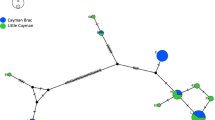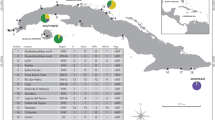Abstract
The current range of wolverines (Gulo gulo) within the lower 48 states includes small, remnant populations in Idaho, Washington, Wyoming and Montana. The size and trend of each of these populations and connectivity to adjacent populations in the contiguous United States and Canada are poorly understood. In this study, levels of genetic diversity and population genetic structure were examined in three states (Idaho, Wyoming, and Montana) and two Canadian provinces (Alberta and British Columbia) using both mitochondrial (mtDNA) and nuclear microsatellite DNA. Restricted levels of gene flow were detected among these populations with mitochondrial and nuclear DNA and our observations suggest a pattern of male-mediated gene flow. Populations in the United States appear to be receiving migrants from Canada, however, substantial genetic differentiation suggests that gene flow may not be high enough to prevent genetic drift. Our analyses suggest that at least 400 breeding pairs or 1–2 effective migrants per generation would be needed to ensure genetic viability in the long-term for each of the populations in the United States. Significant matrilineal structuring and restricted female gene flow indicates that demographic viability will depend upon the movement of female wolverines into new territories. Results from this study provide guidelines for conservation and management and indicate the need for more ecological data.
Similar content being viewed by others
References
Amos W, Balmford A, (2001) When does conservation genetics matter?. Hered ity 87:257–265
Archie JW (1985) Statistical analysis of heterozygosity data: Independent sample comparisons. Evolution 39:623–637
Banci V (1987) Ecology and behavior of wolverine in Yukon. MS thesis, Simon Fraser University, Burnaby, BC
Banci V (1994) Wolverine. In: The Scientific Basis for Conserving Forest Carnivores, American Marten, Fisher Lynx, and Wolverine in the Western United States (eds. Ruggiero LF, Aubry KB, Buskirk SW, Lyon LJ, Zielinski WJ). USDA For. Env. Rocky Mt. For and Range. Exp. Stn., Gen Tech Rep. RM-254 1-184, Fort Collins, CO
Bryant HN (1987) Wolverine from the Pleistocene of the Yukon: Evolutionary trends and taxonomy of Gulo (Carnivora: Mustelidae). Can. J. Earth Sci. 24:654–663
Carroll C, Noss RF, Paquet PC (2001) Carnivores as focal species for conservation planning in the Rocky Mountain region. Ecol. Appl. 11:961–980
Cavalli-Sforza LL, Edwards AWF (1967) Phylogenetic analysis: Models and estimation procedures. Evolution 32:550–570
Cegelski CC, Waits LP, Anderson NJ (2003) Assessing population structure and gene flow in Montana wolverines (Gulo gulo) using assignment-based approaches. Mol. Ecol. 12:2907–2918
Chappell DE, Van Den Bussche RA, Kriza J, Patterson B (2004) Contrasting levels of genetic differentiation among populations of wolverines (Gulo gulo) from northern Canada revealed by nuclear and mitochondrial loci. Conserv. Genetics 5:759–767
Clement M, Posada D, Crandall KA (2000) TCS, a computer program to estimate gene genealogies. Mol. Ecol. 9:1657–1659
Coltman DW, Bowen DW, Wright JM (1998) Birth weight and neonatal survival of harbour seal pups are positively correlated with genetic variation measured by microsatellites. Proc. R. Soc. Lond. B. Biol. Sci. 265:803–809
Copeland J (1998) Biology of the wolverine in central Idaho. MS thesis, University of Idaho, Moscow, Idaho
Dallas JF, Piertney SB (1998) Microsatellite primers for the Eurasian otter. Mol. Ecol. 7:1247–1263
Davis CS, Strobeck C (1998) Isolation, variability, and cross-species amplification of polymorphic microsatellite loci in the family Mustelidae. Mol. Ecol. 7:1771–1788
Duffy AJ, Landa A, O’Connell M, Stratton C, Wright JM (1998) Four polymorphic microsatellites in wolverine. Gulo gulo. Anim. Genet. 29:63–72
Edelmann F, Copeland J (1999) Wolverine distribution in the Northwestern United States and a survey in the Seven Devils Mountains of Idaho. Northwest Sci. 73:295–304
England PR, Osler GHR (2001) GENELOSS: A computer program for simulating the effects of population bottlenecks on genetic diversity. Mol. Ecol. Notes 1:111–113
Excoffier L, Smouse PE, Quattro JM (1992) Analysis of molecular variance inferred from metric distances among DNA haplotypes: Application to human mitochondrial DNA restriction data. Genetics 131:479–491
Frankham R (1995) Inbreeding and extinction: A threshold effect. Conserv. Biol. 9:792–799
Flagstad O, Hedmark E, Landa A, Broseth H, Persson J, Andersen R, Segerstrom P, Ellegren H (2004) Colonization history and noninvasive monitoring of a reestablished wolverine population. Conserv. Biol. 18:676–688
Guglich EA, Wilson PJ, White BN (1994) Forensic application of repetitive DNA markers to the species identification of animal tissues. J. Forensic Sci. 39:353–361
Haglund B (1966). Winter habits of the Lynx (Lynx lynx L.) and wolverine (Gulo gulo L.) as revealed by tracking in the snow. Vilvetry 4:81–309
Hall ER (1981) The mammals of North America. 2nd ed. 2 vol. John Wiley & Sons, New York
Hanski I, Gilpin M (eds) (1997) Metapopulation Biology, Ecology, Genetic, and Evolution. Academic press, San Diego
Hash HS (1987) Wolverine. In: Nowak M, Baker J, Obbard M, Malloch B (eds) Wild Furbearer Management and Conservation in North America. Ministry of Natural Resources, Ontario, pp. 574–585
Hedrick PW, Miller P (1992) Conservation genetics: Techniques and fundamentals. Ecol. App. 2:30–46
Holsinger KE (2000) Demography and extinction in small populations. In: Young A, Clarke G (eds) Genetics, demography, and the viability of fragmented populations. Cambridge University Press, Cambridge, pp. 55–74
Hornocker MG, Hash HS (1981) Ecology of the wolverine in northwestern Montana. Can. J. Zoo. 59:1286–1301
Inman KH, Inman RM, Wigglesworth RR, McCue AJ, Brock BL, Rieck JD, Harrower W (2003) Greater Yellowstone Wolverine Study, CumulativeProgress Report December 2003, Wildlife Conservation Society General Technical Report. 36 pp
Knowles LL, Maddison WP (2002) Statistical phylogeography. Mol. Ecol. 11:2623–2635
Krebs JA, Lewis D (1999) Wolverine Ecology and habitat use in the North Columbia Mountains: Progress Report. Proceedings of Biology and Management of Species at Risk, Kamloops BC
Kyle CJ, Strobeck C (2001) Genetic Structure of North American wolverine (Gulo gulo) Populations. Mol. Ecol. 10:337–347
Kyle CJ, Strobeck C (2002) Connectivity of peripheral and core populations of North American wolverines. J. Mamm. 83:1141–1150
Krott P (1960) Ways of the wolverine. Nat. Hist. 69:136–150
Langella O (2001) Populations 1.2.24. Population genetic structure (individuals or populations distances, phylogenetic␣trees). http://www.pge.cnrs.gif.fr/bioinfo/populations/ (March 2005)
Madsen T, Shine R, Olsson M, Wittzell H (1999) Restoration of an inbred adder population. Nature 404:34–35
Magoun AJ (1985) Population characteristics, ecology and management of wolverines in northwestern Alaska. PhD thesis, University of Alaska, Fairbanks, Alaska
Mantel N (1967) The detection of disease clustering and generalized regression approach. Cancer Res. 27:209–220
Miller CR, Waits LP (2003) The history of effective population size and genetic diversity in the Yellowstone grizzly (Ursus arctos): Implications for conservation. Proc. Natl. Acad. Sci. 7:4334–4339
Murray JA (1987) Wildlife in Peril: The Endangered Mammals of Colorado: River Otter, Black-footed Ferret, Wolverine, Lynx, Grizzly Bear, Gray Wolf. Roberts Rinchart Publishers, Boulder, Colorado
Nei M (1978) Estimation of average heterozygosity and genetic distance from a small number of individuals. Genetics 89:583–590
Nei M (1987) Molecular Evolutionary Genetics. Columbia University Press, New York
Paetkau D, Slade R, Burden M, Estoup A (2004) Genetic assignment methods for the direct, real-time estimation of migration rate: A simulation-based exploration of accuracy and power. Mol. Ecol. 13:55–65
Posada D, Crandall KA, Templeton AR (2000) GeoDis, a program for the cladistic nested analysis of the geographical distribution of genetic haplotypes. Mol. Ecol. 9:487–488
Pritchard JK, Stephens M, Donnelly P (2000) Inference of population structure using multilocus genotype data. Genetics 155:945–959
Pulliainen E (1968) Breeding biology of the wolverine (Gulo gulo L.) in Finland. Ann. Zool. Fenni. 5:338–344
Raymond M, Rousset F (1995) GENEPOP (version 1.2): Population genetic software for exact tests and ecumenicism. J. Hered. 86:248–249
Reed DH, Frankham R (2001) How closely correlated are molecular and quantitative measures of genetic variation? A meta-analysis. Evolution 55:1095–1103
Reed DH, Frankham R (2003) Correlation between fitness and genetic diversity. Conserv. Biol. 17:230–237
Rice WR (1989) Analyzing tables of statistical tests. Evolution 43:223–225
Schneider S, Roessli D, Excoffier L (2000) Arlequin ver. 2.0: A software for population genetic data analysis. Genetics and Biometry Laboratory, University of Geneva, Switzerland
Schreiber A, Wirth R, Riffel M, Van Rompaey H (1989) Weasels, civets, mongooses, and their relatives: An action plan for the conservation of mustelids and viverrids. IUCN. Gland, Switzerland
Storfer A (1999) Gene flow and endangered species translocations: a topic revisited. Biol. Conserv. 87:173–180
Swafford DL (1998) PAUP* Phylogenetic Analysis Using Parsimony (*and other methods), Version 3, Sinauer Associates, Sunderland, Massachusetts
Taylor H (2000) IUCN Red List of Threatened Species. IUCN. Gland, Switzerland and Cambridge
Templeton AR (1998) Nested clade analysis of phylogeographic data: Testing hypotheses about gene flow and population history. Mol. Ecol. 7:381–397
Templeton AR (2004) Statistical phlogeography: Methods of evaluating and minimizing inference errors. Mol. Ecol. 13:789–809
Templeton AR, Sing CF (1993) A cladistic analysis of phenotypic associations with haplotypes inferred from restriction endonuclease mapping. IV. Nested analyses with cladogram uncertainty and recombination. Genetics 134:659–669
Templeton AR, Crandall KA, Sing CF (1992) A cladistic analysis of phenotypic associations with haplotypes inferred from restriction endonuclease mapping and DNA sequence data. III. Cladogram estimation. Genetics 132:619–633
Templeton AR, Routman E, Philips C (1995) Separating population structure from population history: a cladistic analysis of the geographical distribution of mitochondrial DNA haplotypes in the Tiger Salamander. Ambystoma tigrinum. Genetics 140:767–782
Tomasik E, Cook JA (2005) Mitochondrial phylogeography and conservation genetics of wolverine (Gulo gulo) of northwestern North America. J. Mammal. 86:386–396
USFWS (1995) Endangered and threatened wildlife and plants: 90 day finding for a petition to list as endangered or threatened the contiguous United States population of the North American wolverine. Fed. Regist. 60:19567–19568
USFWS (2003) Endangered and threatened wildlife and plants: 90 day finding for a petition to list as endangered or threatened wolverine in the contiguous United States. Fed. Regist. 68:60112–60115
Vangen KM, Persson J, Landa A, Anderson R, Segerstrom P (2001) Characteristics of dispersal in wolverines. Can. J. Zool. 79:1641–1649
Weir BS, Cockerham CC (1984) Estimating F-statistics for the analysis of population structure. Evolution 38: 1358–1370
Westemeier RJ, Brawn S, Simpson T, Esker J, Jansen J, Walk J, Kershner E, Bouzat J, Paige K (1998) Tracking the long-term decline and recovery of an isolated population. Science 282:1695–1698
Wilson GM, Van Den Bussche RA, Kennedy PK, Gunn A, Poole K (2000) Genetic variability of wolverines (Gulo gulo) from the Northwest Territories, Canada: Conservation implications. J. Mammal. 81:186–196
Author information
Authors and Affiliations
Corresponding author
Rights and permissions
About this article
Cite this article
Cegelski, C., Waits, L., Anderson, N. et al. Genetic diversity and population structure of wolverine (Gulo gulo) populations at the southern edge of their current distribution in North America with implications for genetic viability. Conserv Genet 7, 197–211 (2006). https://doi.org/10.1007/s10592-006-9126-9
Received:
Accepted:
Published:
Issue Date:
DOI: https://doi.org/10.1007/s10592-006-9126-9




